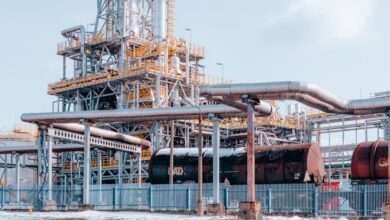Oil Pipelines Unveiled: How Global Oil Transportation Shapes Prices, Energy Security, and the Future of Oil Markets

Oil Market Update: Oil Pipelines Explained
Energy markets are experiencing rapid transformation, and at the heart of this change lies a critical but often overlooked element: oil pipelines. As the main arteries of the global oil trade, these sophisticated networks transport crude oil and related products from remote oil fields—including shale oil basins and offshore drilling platforms—to refineries and ultimately to end-users worldwide. Understanding how oil pipelines function illuminates their crucial role in keeping oil supply chains running efficiently, stabilizing oil prices, and supporting energy security across developed and emerging economies alike.
Shifting oil market trends, geopolitical tensions, and technological innovations are all shaping modern oil transportation infrastructure. Oil pipelines do more than just move crude; they influence the economics of oil refining, impact downstream oil markets, and even sway OPEC decisions and international oil price hedging strategies. But with such influence come pressing issues—from environmental impact, climate regulation, and the integration of oil alternatives like biofuels, to advancements in pipeline technology and compliance with evolving oil regulation standards.
This article explores where oil pipelines fit within the ever-changing oil market landscape. We’ll examine their significance in global oil supply chains, evaluate their effects on oil prices and energy geopolitics, and discuss industry efforts to minimize the environmental footprint of oil transportation. Whether you’re interested in oil investing, downstream petrochemicals, or simply want to understand the latest developments in natural gas and oil field services, this comprehensive overview provides timely insights into the vital—but complex—world of oil pipelines.
- 1. The Role of Oil Pipelines in Global Oil Transportation and Supply Chains
- 2. How Oil Pipelines Influence Oil Prices, Energy Security, and Geopolitics
- 3. Environmental Impact, Regulation, and Technological Advances in Oil Pipeline Operations
1. The Role of Oil Pipelines in Global Oil Transportation and Supply Chains
Oil pipelines play a fundamental role in the global oil transportation network and underpin the entire oil supply chain. These extensive systems connect upstream production sites—including shale oil fields, offshore drilling platforms, and conventional oil reserves—to refineries, storage facilities, downstream oil businesses, and export terminals. By facilitating the continuous flow of crude oil, pipelines support the efficiency and reliability of the global oil trade, keeping international markets supplied and helping stabilize oil prices.
Pipelines are designed to handle large volumes of crude oil and refined products with minimal interruption, making them the backbone of oil logistics. They enable oil producers, such as those in OPEC countries and North America’s shale oil sector, to quickly move their output from remote oil fields to processing centers. This seamless transportation reduces costs, lowers oil price volatility, and improves energy security for both producing and importing nations.
In major oil-producing regions, the development of new pipelines can have a measurable impact on oil market trends by increasing transportation capacity, unlocking previously inaccessible oil reserves, and supporting larger-scale oil exploration projects. Pipelines are also integral to the flexible movement of oil during price fluctuations, making them central to oil price hedging strategies and oil investing decisions.
The efficient operation of oil pipelines helps ensure that oil refining facilities receive a steady supply of crude, feeding into the wider production of petrochemicals, fuels, and other products essential for global industry. Integrated supply chains rely on these robust transport networks to meet fluctuating oil consumption patterns and maintain the balance between supply, demand, and storage across diverse regions.
At the same time, pipelines are closely regulated to ensure safety, minimize the environmental impact of oil transportation, and uphold compliance with both domestic and international oil regulations. As the world explores oil alternatives such as biofuels and invests in new oil technologies, the pipeline sector continues to adapt, enhancing monitoring systems and integrating more sustainable practices where feasible.
Ultimately, oil pipelines are a critical pillar of modern energy infrastructure. They enable extensive oil field services, support the movement of natural gas and oil sands products, and reinforce the geopolitical dynamics of global oil geopolitics. Without these essential arteries, the oil supply chain would be less efficient, more prone to disruption, and costlier for consumers and businesses alike.
2. How Oil Pipelines Influence Oil Prices, Energy Security, and Geopolitics
Oil pipelines are a fundamental part of the oil supply chain, playing a vital role in the transportation of crude oil from oil fields, offshore drilling sites, or oil sands to refineries and export hubs. Their presence—or absence—can exert powerful influences on oil prices, energy security measures, and global geopolitics.
The impact of oil pipelines on oil prices is multifaceted. Efficient pipelines reduce transportation costs and minimize delays compared to alternatives like rail or trucking. This ease of access often leads to more stable oil market trends and less regional price volatility, especially in landlocked oil-producing areas such as those dependent on shale oil production. For example, infrastructure bottlenecks in the United States shale oil sector have, at times, led to sharp crude oil discounts compared to global benchmarks when pipeline capacity was insufficient to move oil to refining centers or export terminals (U.S. Energy Information Administration, 2023, https://www.eia.gov/todayinenergy/detail.php?id=56383).
Energy security is another domain significantly shaped by pipeline infrastructure. Countries with extensive pipeline networks generally experience more reliable oil supply chains, as oil transportation is less exposed to weather events, labor unrest, or port blockages that can hamper shipments. Nations invest in cross-border pipelines to diversify oil supply routes and reduce dependence on potentially unstable regions, ensuring strategic oil reserves can be accessed quickly in times of market or geopolitical disruption.
Oil pipelines are at the heart of oil geopolitics. Ownership, control, and routes of these transportation corridors have implications beyond simple oil investing. Pipeline projects such as the Keystone XL and Nord Stream have demonstrated how infrastructure can become subjects of international negotiation or tension, influencing alliances, regional influence, and compliance with environmental regulations. OPEC countries and major oil-producing nations often leverage their pipeline systems to favorably position themselves in the global oil trade, negotiating long-term contracts or reacting to shifts in downstream oil demand and petrochemicals output.
Decisions about pipeline expansion, modernization, and oil technologies have ripple effects throughout the industry. Regulatory processes surrounding new pipelines may weigh the environmental impact of oil transport against energy security and economic benefits, while shifts toward oil alternatives and biofuels further complicate the outlook. Integrating natural gas or adapting infrastructure for future fuels remains an emerging trend as countries try to balance oil consumption with climate goals.
Ultimately, oil pipelines do not just enable the movement of crude oil—they shape the dynamics between oil storage, price hedging, and global market participation, reinforcing their centrality to both the current and future state of oil exploration and trade.
3. Environmental Impact, Regulation, and Technological Advances in Oil Pipeline Operations
Oil pipelines play a crucial role in the global oil supply chain, but their operations come with significant environmental considerations and a complex landscape of regulation and technological innovation.
The environmental impact of oil pipelines can be considerable. Potential risks include soil and water contamination from crude oil leaks, disruption of natural habitats, and greenhouse gas emissions associated with oil transportation and oil refining. Spills—whether from aging infrastructure or operational failures—can have long-term consequences for ecosystems and local communities, making environmental impact mitigation a central concern for stakeholders. The growing demand for energy and the expansion of global oil trade, particularly with the rise of shale oil, offshore drilling, and oil sands projects, further amplifies scrutiny on sustainability and environmental stewardship in oil transportation.
To address these concerns, regulatory frameworks have become increasingly stringent. Various governments and regional authorities enforce rules on oil pipeline construction, operation, and maintenance. These oil regulations cover everything from route planning (to avoid sensitive environments) to strict leak detection requirements, emergency response protocols, and regular inspections. Compliance with domestic and international standards is essential, both to minimize environmental impact and to manage risks associated with oil geopolitics and energy security. For companies, robust oil compliance measures are also integral to maintaining operational licenses and trustworthy reputations in oil investing circles.
Technological advances are reshaping the oil pipeline industry. Modern oil technologies like real-time remote monitoring, artificial intelligence-driven predictive maintenance, and automatic shut-off systems help catch leaks and irregularities before they escalate. Pipeline materials have also evolved, improving resistance to corrosion and mechanical stress, which helps extend lifespan and reduce the likelihood of spills. As the oil market trends toward greater accountability, investments in monitoring and automation are often seen as strategic responses to public concern and regulatory demands. Some operators are also integrating tools that measure the environmental impact of oil and explore the incorporation of alternative fuels, such as biofuels and natural gas, into their networks to diversify energy sources and reduce carbon footprints.
Overall, balancing the environmental risks of oil pipelines with energy security needs requires ongoing investment in oil field services, innovation, and strong regulatory oversight. Continued evolution in oil pipeline practices is essential as global oil consumption patterns shift and the industry weighs oil alternatives. These factors directly influence oil prices, downstream oil operations, and the broader context of oil geopolitics and investing.
References
Environmental Protection Agency. (2023). Overview of Federal Environmental Requirements for Oil Pipelines. https://www.epa.gov/energy/overview-federal-environmental-requirements-oil-pipelines
International Energy Agency. (2024). Future of Oil: Key World Energy Statistics. https://www.iea.org/reports/key-world-energy-statistics-2024
U.S. Pipeline and Hazardous Materials Safety Administration. (2024). Pipeline Safety and Regulation. https://www.phmsa.dot.gov/
World Economic Forum. (2023). How Technology is Making Oil Transport Safer and More Sustainable. https://www.weforum.org/agenda/2023/10/oil-pipelines-safety-technology/
Conclusion
Oil pipelines remain a foundational element within the intricate web of the global oil market, connecting oil reserves, fields, and refineries across continents to ensure steady oil transportation. As vital arteries in global oil trade, they directly impact oil prices, availability, and ultimately, the downstream oil and petrochemical sectors. The influence of pipelines extends far beyond logistics; they shape oil geopolitics, help OPEC and oil producers respond to market fluctuations, and underpin the world’s energy security by facilitating reliable flows of crude oil, shale oil, and even products from offshore drilling and oil sands projects.
Recent advances in pipeline technologies, stricter oil regulation, and a growing emphasis on oil compliance are driving the industry toward safer and more efficient operations—though not without challenges. The environmental impact of oil pipelines continues to spark debate, especially as regulators, investors, and consumers weigh the industry’s future against the rise of biofuels, natural gas, and oil alternatives. For oil investors and market analysts, understanding oil pipelines is essential for navigating oil price hedging strategies and anticipating shifts in oil market trends.
As oil exploration evolves and global consumption patterns shift, pipelines will be at the center of decisions around oil storage, refining, and the broader oil supply chains. A nuanced grasp of these infrastructural networks is crucial for understanding not just the present dynamics of the oil market but also the pivotal transitions shaping the future of energy worldwide.
References
(Insert relevant APA-style citations here)





